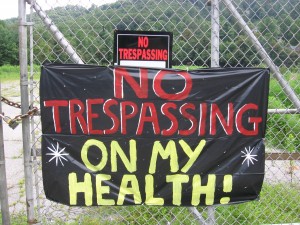>> I’ve seen >>Erin Brockovich. You probably have too. It’s the unbelievable yet true story of a water company that polluted the community’s water supply and hurt its people’s health. That happened back in the 1990’s – but there’s no way it could be happening now, right?
I’ve seen >>Erin Brockovich. You probably have too. It’s the unbelievable yet true story of a water company that polluted the community’s water supply and hurt its people’s health. That happened back in the 1990’s – but there’s no way it could be happening now, right?
A few weeks ago, a Facebook update from a dear friend caught my attention. She and her family live just yards away from an old industrial site. When they bought the house, they knew about the site but were assured that it posed no threat to their health. Now, some five years later, my friend has been told by the EPA that the site could be impacting their air quality, and therefore their health.
The site I’m referring to is the >>now-closed CTS site in Mills Gap, NC, just south of Asheville. (The site is so-named because it belonged to CTS Corporation, an electronics manufacturer for auto parts and hearing aids.) The site closed in 1986 after 27 years of operation. The EPA declared it a “Superfund site” two years ago.
A Superfund site is defined as an “uncontrolled or abandoned place where hazardous waste is located, possibly affecting local ecosystems or people.” >>Check out this list from the EPA to see the Superfund sites near you.
Initially, authorities believed that groundwater was the only thing contaminated by the CTS site in Mills Gap. For years, the only people who took precautionary steps were those who drink well water near the site.
With air quality now also in question, my friend is scared for the health of her sons, and concerned about the impact on the site’s value of their home. She has reason to worry. Recently I spoke with Lee Ann Smith, who also lives near the CTS site.
When Lee Ann’s boys were little, they played in the woods near the closed site well before anyone knew it could pose a danger. Ten years ago, her son was diagnosed with thyroid cancer, and her other son discovered a benign bone tumor. Her son’s oncologist had one question for Lee Ann – “Had they ever been to >>Chernobyl?”
This reads like “Erin Brockovich II,” right?
CTS Corporation– still in operation– had instructions to clean up the Mills Gap site years ago. Now that it has become a Superfund site, it will at some point have to get handled—but what happens to people like my friend and Lee Ann in the meantime?
The problem is there are thousands of Superfund sites in the United States, but not enough funding to clean them up or enforcement to make the responsible companies do their part.
Lee Ann is doing what she can. Several years ago she created the advocacy group >>P.O.W.E.R. to advocate for the clean-up of the CTS site. She recently celebrated a success. Believe it or not, >>CTS recently filed a lawsuit against the EPA demanding that the Mills River site be taken off the Superfund list. Why? Because if the CTS site is not listed as a Superfund, CTS Corporation only has to pay $5 million towards clean-up costs. The rest of the clean-up costs would be pushed onto taxpayers. Thankfully, that request was denied last week by a D.C. Court of Appeals.
What can we do? Pay attention to the areas around you. >>Check out that list of sites. Because if this story turns into another movie, I want it to have a happy ending, don’t you?
Were are these sites I am new to NC?
Thanks for your question, and welcome to NC! The CTS Superfund site is located just outside of Asheville, which is situated in the mountains (western part) of North Carolina. You can view a list of other Superfund sites in our state on the EPA website: http://www.epa.gov/region4/superfund/allresource/mapping/states/nc.html. Thanks for reading!